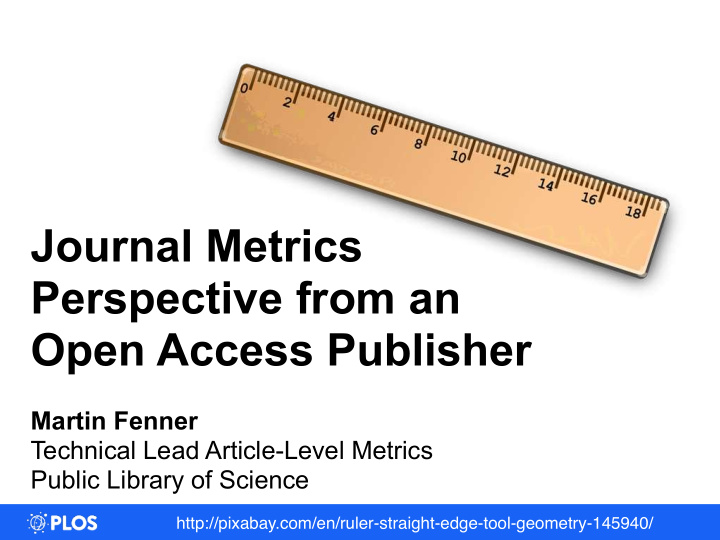



Open Metrics Journal Metrics Perspective from an Open Access Publisher Martin Fenner Technical Lead Article-Level Metrics Public Library of Science http://pixabay.com/en/ruler-straight-edge-tool-geometry-145940/
Usage Stats Most immediate metric that directly reflects usage Only useful if data are collected in a standardized way – COUNTER is the standard and looks at HTTP status codes, double-click intervals, and excludes robots
http://open-access.net/fileadmin/OAT/OAT14/Tage-Koeln-Traue_keiner_Statistik_Recke_2014.pdf
Usage is different from scholarly citations 34113 Scopus HTML Citations ≥ 10 Views ≥ 2000 2854 3247 2558 42,772 PLOS ONE Papers Metrics collected August 8, 2012 4
Citations Citations have become a proxy for scholarly impact Many problems with unreflected use of citation metrics, in particular in the assessment of individual researchers http://dx.doi.org/10.1371/journal.pone.0063184
Citations are collected via reference lists References 6. Ne ´ve ´ol A, Wilbur WJ, Lu Z (2012) Improving links between literature and 1. Kahn P, Hazledine D (1988) NAR’s new requirement for data submission to the biological data with text mining: a case study with GEO, PDB and MEDLINE. EMBL data library: information for authors. Nucleic Acids Res 16(10): I–IV. Database (Oxford) 2012: bas026. 2. Science as an Open Enterprise (2012) The Royal Society. Available: http:// 7. Fink JL, Kushch S, Williams PR, Bourne PE (2008) BioLit: integrating biological royalsociety.org/policy/projects/science-public-enterprise/report/. Accessed literature with databases. Nucleic Acids Res 36(Web Server Issue):W385–9. 2013 Apr 8. 8. Haeussler M, Gerner M, Bergman CM (2011) Annotating genes and genomes 3. Rebholz-Schuhmann D, Arregui M, Gaudan S, Kirsch H, Yepes AJ (2007) Text with DNA sequences extracted from biomedical articles. Bioinformatics processing through Web services: calling Whatizit. Bioinformatics 24(2):296– 27(7):980–6. 298. 9. Finn RD, Mistry J, Tate J, Coggill P, Heger A, et al. (2010) The Pfam protein 4. McEntyre JR, Ananiadou S, Andrews S, Black WJ, Boulderstone R, et al. (2011) families database. Nucleic Acids Res Database Issue 38:D211–222. UKPMC: a full text article resource for the life sciences. Nucleic Acids Res 10. Parkinson H, Sarkans U, Shojatalab M, Abeygunawardena N, Contrino S, et al. 39:d58–65. (2005) ArrayExpress – a public repository for microarray gene expression data at 5. Ne ´ve ´ol A, Wilbur WJ, Lu Z (2011) Extraction of data deposition statements from the EBI. Nucleic Acids Res (2005) 33 (Suppl 1): D553–D555. the literature: a method for automatically tracking research results. Bioinfor- 11. Mulder NJ, Apweiler R, Attwood TK, Bairoch A, Bateman A, et al. (2002) matics 27(23):3306–3312. InterPro: an integrated documentation resource for protein families, domains and functional sites. Brief Bioinform (3):225–35. http://dx.doi.org/10.1371/journal.pone.0063184
Reference lists have to be collected in a central resource and in a standard format
CrossRef's specific mandate is to be the citation linking backbone for all scholarly information in electronic form http://www.crossref.org/01company/02history.html
Limitations CrossRef citation linking built around references that have DOIs from CrossRef members – usually scholarly articles CrossRef Cited-By service only available to CrossRef members for their own articles CrossRef is a non-profit organization with publishers as members – no academic institutions, funders, other stakeholders
Alternative citation indexes for non-publisher users
Reference lists increasingly contain non-article references Fig. 3. STM articles and URI references per publication year - PMC corpus. doi:10.1371/journal.pone.0115253.g003 http://dx.doi.org/10.1371/journal.pone.0115253
DataCite provides DOIs for academic institutions and data centers
DataCite DOIs are not just for datasets http://datacite.labs.orcid-eu.org/help/status
DataCite citation linking works differently, and is separate from CrossRef A DOI is not a DOI http://datacite.labs.orcid-eu.org/help/status
CrossRef and DataCite announce initiative Nov 2014 • Provide comprehensive support for interlinking between articles and data. • Develop open APIs and open source tools to surface citations and other relationships between publications and data sets. • Integrate into their services other existing scholarly communications initiatives such as ORCID and FundRef. • Develop systems, workflows and best practices for using DOIs to reference large, highly granular and dynamic data. https://www.datacite.org/CrossRefDataCiteinitiative
There is more than usage stats and citations RESEARCH ARTICLE VIEWED SAVED DISCUSSED RECOMMENDED CITED PLOS HTML CiteULike NatureBlogs F1000 Prime CrossRef PLOS PDF Mendely ScienceSeeker PMC PLOS XML ResearchBlogging Web of Science PMC HTML PLOS Comments Scopus PMC PDF Wikipedia Twitter Facebook Increasing Engagement http://dx.doi.org/10.3789/isqv25no2.2013.04
PLOS collects metrics from 22 data sources Days since publication August 27, 2014 http://alm.plos.org/articles/info:doi/10.1371/journal.pone.0105948
New metrics not ready for impact assessment Any metric we use should have good reliability (consistency) and validity . More work is needed in these areas for novel assessment metrics such as Mendeley or Twitter. http://en.wikipedia.org/wiki/Validity_(statistics)#mediaviewer/File:Reliability_and_validity.svg
Work on best practices and standards has started Alternative Metrics Initiative Phase 1 White Paper June 6, 2014 Phase II of the project starts in early 2015 http://www.niso.org/topics/tl/altmetrics_initiative/
Altmetrics data can be obtained from commercial service providers
Open source software to collect and analyze the metrics data https://github.com/articlemetrics/lagotto https://github.com/articlemetrics/alm-report
CrossRef DOI Event Tracker (DET) Pilot CrossRef Labs has started a pilot project to collect events around all CrossRef DOIs issued since January 2011. A DOI Event Tracker (DET) CrossRef working group was formed in May 2014, initiated by members of the Open Access Scholarly Publishers Association (OASPA). The service is available at http://det.labs.crossref.org, and is using the Lagotto open source software.
This presentation is made available under a CC-BY 4.0 license. http://creativecommons.org/licenses/by/4.0/
Recommend
More recommend